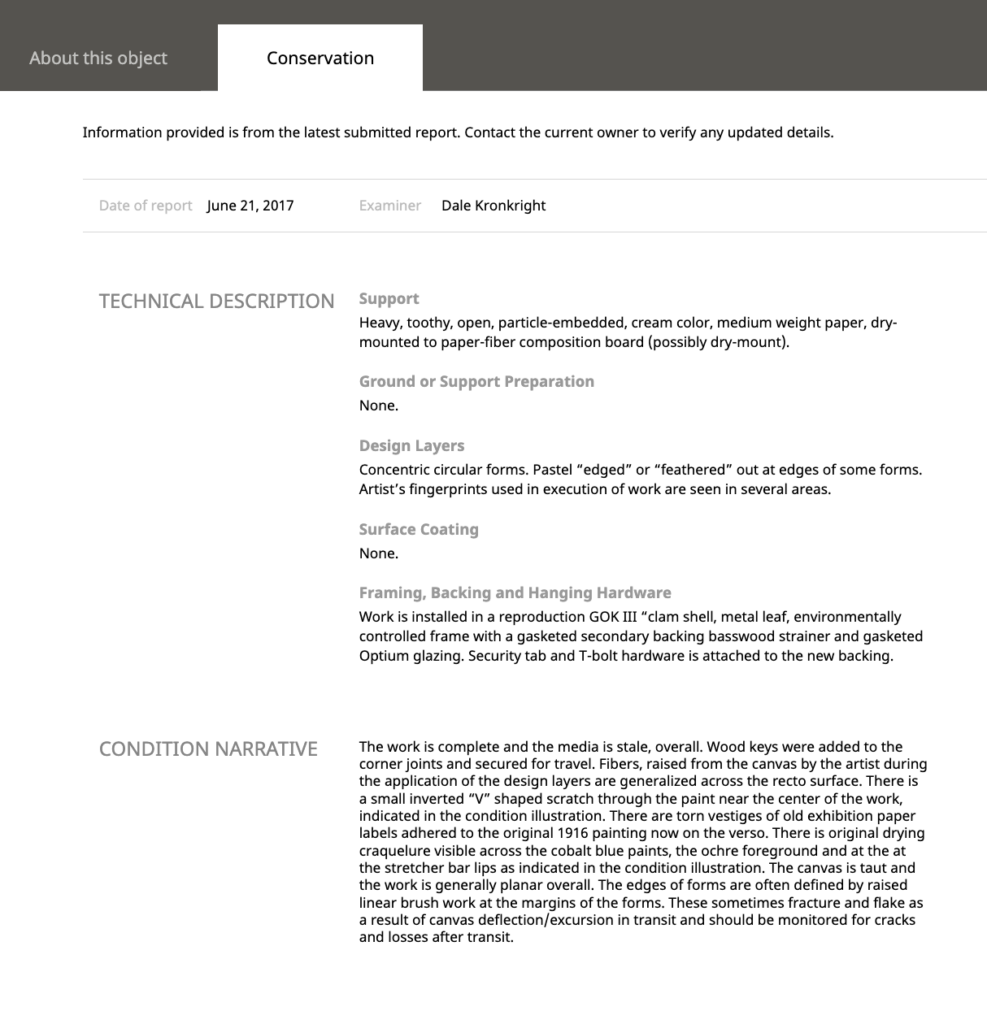Conservation and Technical Documentation
Access O’Keeffe aims to provide information about the physical characteristics and art-making processes of Georgia O’Keeffe artwork when available. Sourced from examinations made by conservators, Access O’Keeffe publishes approved Technical Descriptions and Condition Narratives. Reports are not available for all Georgia O’Keeffe artworks.
Conservation Information Example
Artwork
Untitled (Road to Pedernal), 1941
Georgia O’Keeffe
Georgia O’Keeffe Museum
Report Information
Report author: Dale Kronkright
Report date: 7/12/2012
Technical Description
Support: The support is a medium weight, 2 x 1, cotton canvas over an end-butt-joined, mortise-and-tenon, commercial wood stretcher. All keys (new) are extant and secured for travel. The canvas has another oil painting on the verso. The canvas type, weave and stretcher and paint application techniques of the verso painting are unprecedented for documented works by O’Keeffe, raising the question as to whether O’Keeffe appropriated a painting by another artist, perhaps her framer George Of, for the execution of the tent painting.
Ground or Support Preparation: There is no ground or primer layer under the recto design layers. The composition is painted on the unsized, unprimed verso of another canvas painting, with many loose fibers that likewise appear to be unsized, giving the painting a “fuzzy” overall surface appearance.
Design Layers: Graphite underdrawing is not visible at margins of adjacent forms, as in most works by O’Keeffe. The work is executed in multiple layers of rich, paste-like paints. UV induced visible fluorescence suggests that the work was initially painted wet-into-wet, with broad areas brushed lightly and superficially with a lightly loaded brush, leaving many holidays of unpainted raw canvas visible in the low relief of the canvas texture. The initial forms were then brushed over with additional paints, largely wet over dry, with the major forms outlined. UV-induced luminescence suggests that the artist also amended some of the secondary, wet-into-dry overpaints with a resin that clearly fluoresces light blue in distinct
Surface Coating: The painting has a moderately thick, glossy, synthetic sprayed (supposed PVA AYAF) varnish that appears to have partially nebulized during application, forming small, discrete droplets on the surface of the painting, which did not level or blend. The result is a highly-glossy, artificially saturated, somewhat “sparkled” appearance generalized over the surface of the work. The PVA varnish may have been applied in an attempt to re-saturate blanching paint amendments that had migrated and morphed on the surface as a result of exposure to elevated temperatures.
Framing, Backing and Hanging Hardware: The painting is installed in a 2009 reproduction, O’Keeffe/George Of “clam-shell” micro-climate frame with Volara gasketing at the glazing and the backing, as well as silica gel felted fabric in the backing panel, conditioned at 45% RH. The glazing is Optium, tin-optically coated, non-reflective acrylic. Frame materials were updated and reconditioned in 2020.
Condition narrative
The work is complete and the media is stale, overall. Wood keys were added to the corner joints and secured for travel. Fibers, raised from the canvas by the artist during the application of the design layers are generalized across the recto surface. There is a small inverted “V” shaped scratch through the paint near the center of the work, indicated in the condition illustration. There are torn vestiges of old exhibition paper labels adhered to the original 1916 painting now on the verso. There is original drying craquelure visible across the cobalt blue paints, the ochre foreground and at the at the stretcher bar lips as indicated in the condition illustration. The canvas is taut and the work is generally planar overall. The edges of forms are often defined by raised linear brush work at the margins of the forms. These sometimes fracture and flake as a result of canvas deflection/excursion in transit and should be monitored for cracks and losses after transit.
